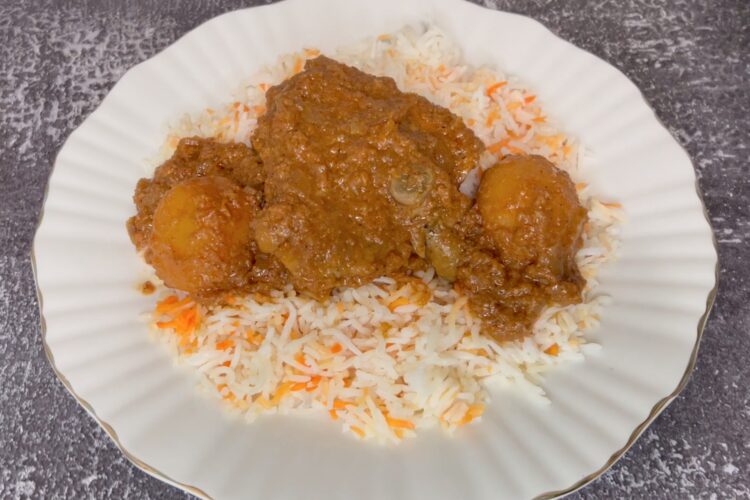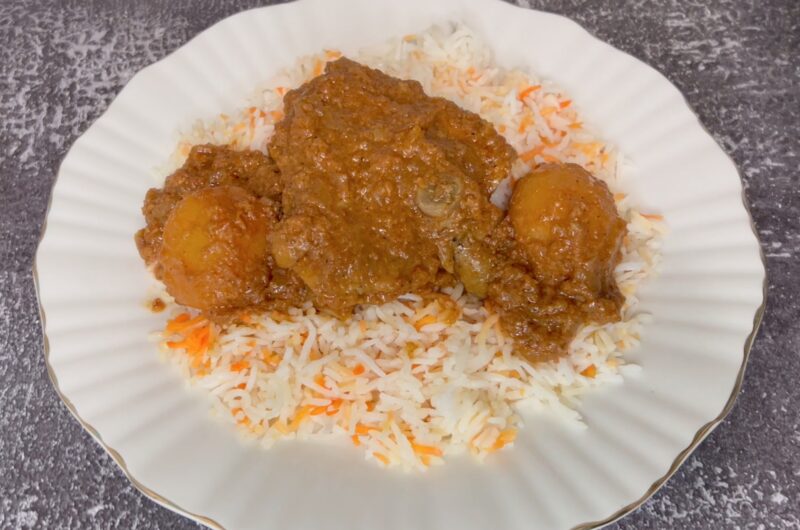This post may contain affiliate links, which means I may receive a commission from purchases made through the links.
Biryani, or biriani as it is commonly referred to in Swahili, is a rice and meat dish that is all about color and flavor. It is truly rich in both aspects. You do not necessarily have to color your rice or the potatoes, but almost every biriani cook in Kenya does this. It is the norm for traditional Swahili biriani. As for the flavor, the dish has quite the list of ingredients and each brings a particular flavor that is necessary to form the final rich and deep taste that is emblematic of biryani. Explore this delicious chicken biryani recipe, give it a try, and see how marvelous it is.
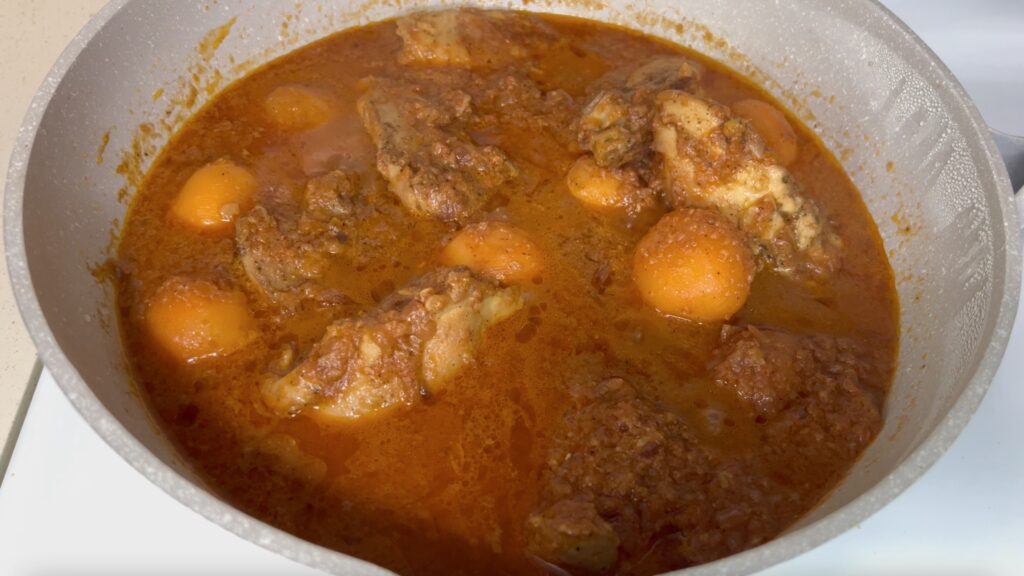
A Brief History of Biriani
Biriani is said to have originated from Persia (modern-day Iran). It then spread across the Middle East and to India and Pakistan and different versions of it emerged as it was adopted in different cultures. It shouldn’t be surprising that this dish is also popular along the Swahili coast, especially in Kenya and Tanzania. The East African coast is heavily inhabited by people of Arab and Indian descent, both whole and partial, mostly due to ancient trade connections between East Africa and these parts of Asia. Biriani is just one of the many dishes of Asian origin that are popular in East Africa and especially along its coast. Others include pilau, chapati, chai (tea), and finger foods like bhajia and samosa.
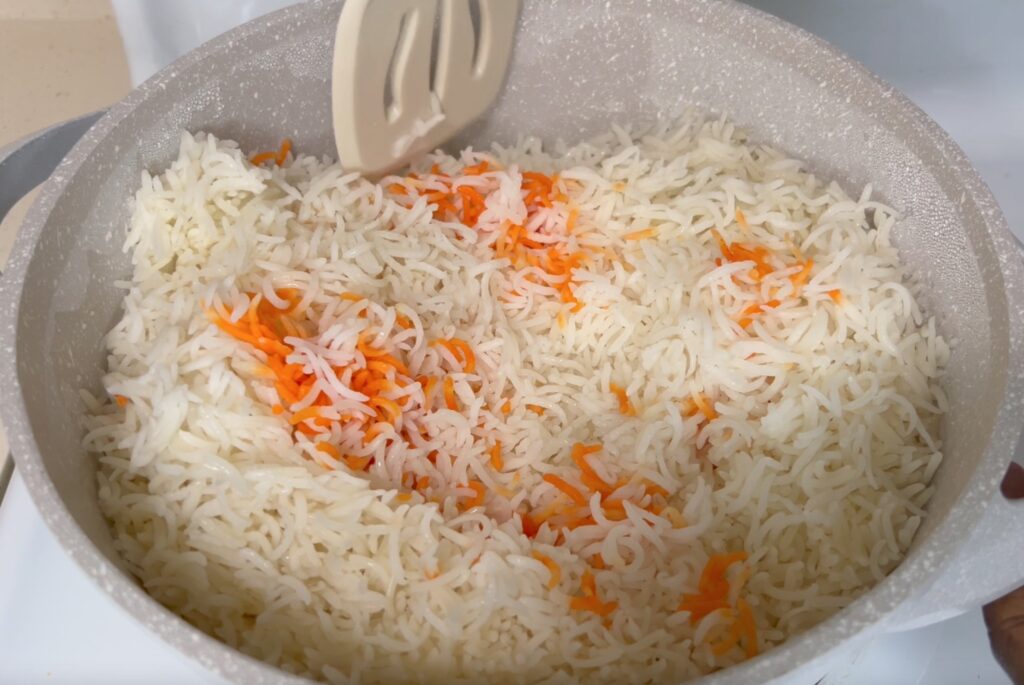
The Typical Swahili Biriani
Swahili biriani is typically a two-part dish. The meat sauce and the rice are cooked separately and combined at the time of serving. That said, some biriani cooks may choose to combine the two parts in the pot before serving. Swahili biriani takes quite a long time to prepare because of its long list of ingredients and steps that must be followed in the right order if the dish is to come out perfectly. In fact, Kenyans joke that coastal people can cook all day and that they could start making dinner at 10 am. This is simply in reference to dishes like this chicken biryani which indeed require a lot of preparation and methodical cooking. I must also mention that coastal people are revered cooks, and their food is adored across the country for this very reason.
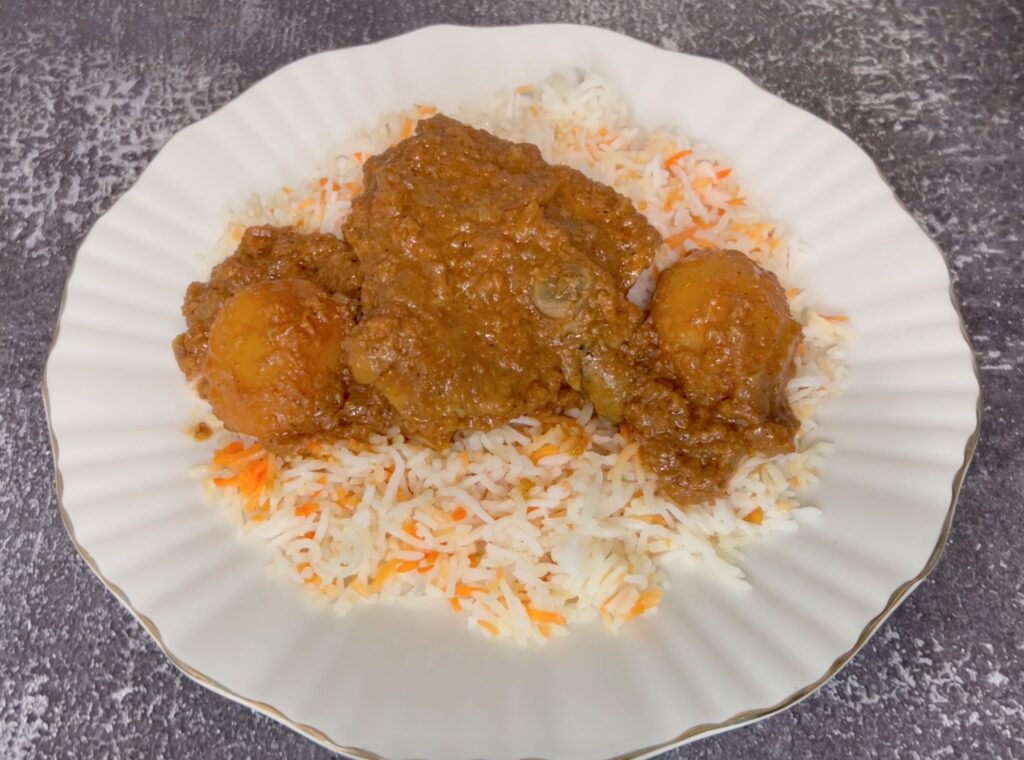
How Popular is Biriani in East Africa?
Biriani is mainly known as a coastal dish in East Africa due to the historical reasons that I mentioned earlier. Therefore, it is more popular in the coastal region than it is in the inner parts of Kenya and Tanzania. I would say, according to my observation as a Kenyan, that pilau, a close counterpart to biriani, is much more popular across East Africa. Perhaps this is because pilau is a one-pot dish that requires less ingredients and takes less time to prepare. You can easily order pilau in any restaurant in Kenya but biriani may be absent in many upcountry restaurants. Even then, many Kenyans prepare biriani in their homes regardless of whether they live on the coast or in the innermost parts of the country.
Ingredients for the Perfect Chicken Biryani
Basmati rice: this is long-grain rice that cooks perfectly and does not clump together. It is important that you use good quality rice for this dish for it to come out perfectly. If you cannot find basmati rice, any other long-grain rice will do as long as it stays loose and keeps its shape when cooked.
Chicken: I used chicken thighs only in this recipe, but you can use a whole chicken cut up into pieces, or any other part of chicken. It really does not matter. Bone-in chicken is great for this recipe but is not required. Also, you can choose to leave the skin on or use skinless chicken like I did. It is basically a matter of personal preference with no harm either way.
Potatoes: Potatoes are included in this dish to further enrich it. I have seen recipes that did not include potatoes as well as those that substituted potatoes with whole-boiled eggs, and all were awesome. I used small yellow potatoes in this recipe because they look cuter to me. However, you can go with large Russet potatoes and cut them into quarters. Just don’t cut them too small as they will cook quickly and could get mushy.
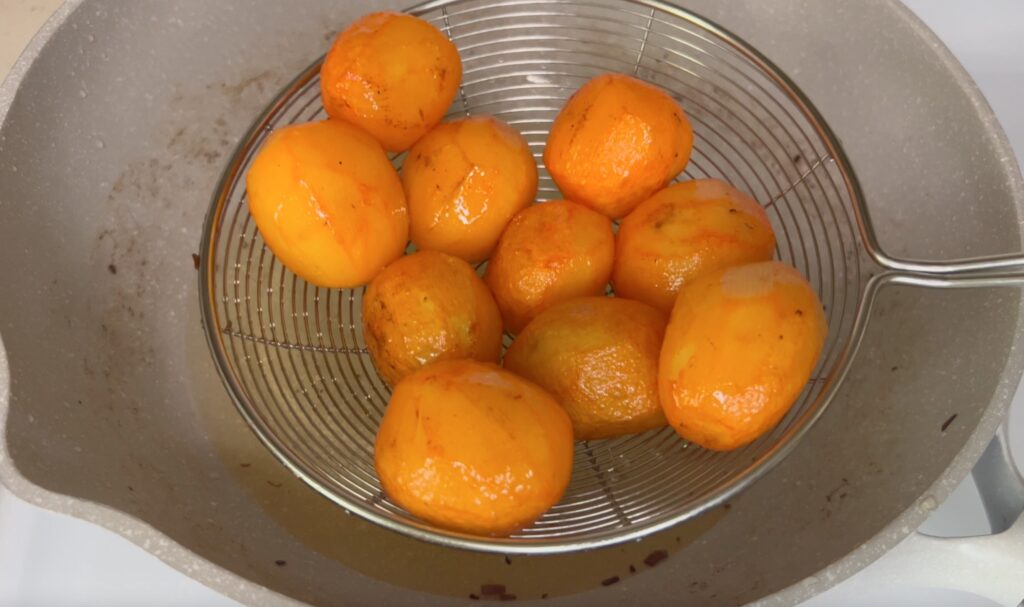
Plain yogurt: this is another ingredient that adds richness to the sauce in both consistency and flavor. Make sure to use unsweetened yogurt so that you do not make the meat sauce unnecessarily sweet.
Biriani masala (or garam masala): Biriani masala, just like pilau masala, contains the same ingredients – cumin, cardamom, cinnamon, cloves, black pepper, and coriander. Those are also the ingredients found in Garam masala. In fact, the smells of these three masalas are barely distinguishable. So, you can use Garam masala in place of Biriani masala.
A quick note on whole vs ground spices: A lot of people in East Africa prefer to use whole spices over ground spices in their pilau and biriani recipes. However, I personally prefer ground spices because I do not like to accidentally chew on a clove or cinnamon stick while enjoying my meal. Also, I do not have to spend time picking these spices off my plate while eating.
Ginger-garlic paste: Adds significant aroma and flavor to the chicken sauce. Fresh is best. Quickly make this paste from a fresh ginger root and a few garlic lobes. I have a small pestle and mortar in my kitchen that is fully dedicated to this job. You can crush the two together, no need to separate them.
Red onions: It is important that you use red onions for this recipe because their flavor, aroma, and texture contribute significantly to the overall appearance and taste of the chicken sauce. I cannot say for sure that any other type of onion would do the same job.
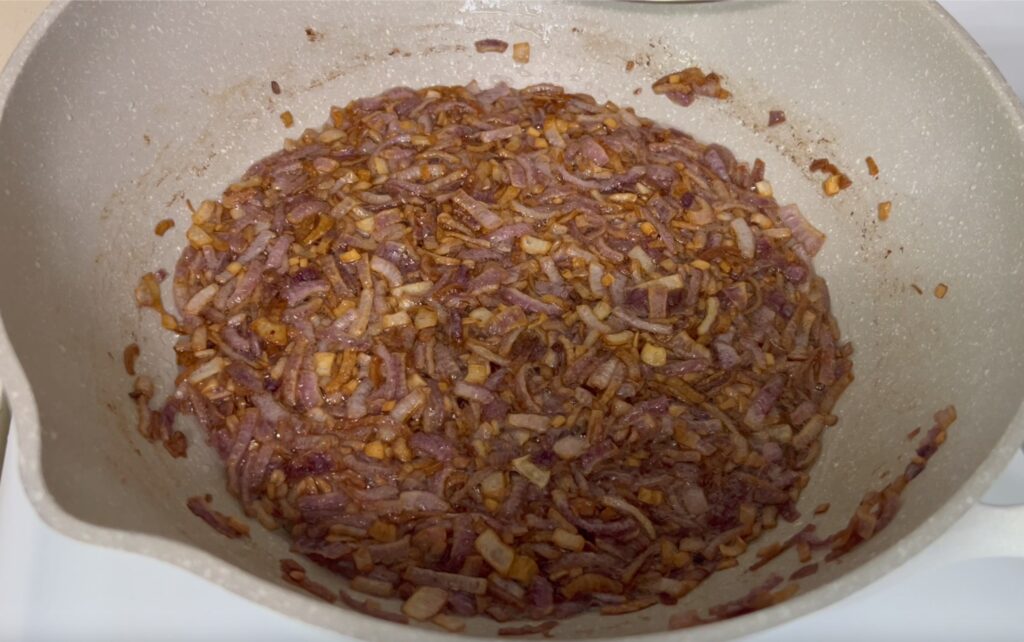
Tomatoes: these make the base of the sauce. This recipe calls for a quite a lot of tomatoes and they should either be pureed or grated for best results. Use fresh tomatoes or the ones you canned at home. I would not recommend store-bought canned tomatoes because their stronger sourness could throw the taste of the dish off.
Tomato paste: this adds to the thickness and color of the meat sauce. The deep red color of tomato paste is a big plus for this dish. However, do not overuse it as it could increase the sourness of the dish.
Chicken masala and ground black pepper: A teaspoon of each of these goes in together with the garam masala. The other half a teaspoon of each is optional for seasoning the chicken before searing.
Cooking oil: You will need this to fry the onion and potatoes, and a little bit for preparing the sauce and rice.
Food coloring: Use the orange food coloring to color the potatoes before frying, and the rice towards the end of cooking. As mentioned earlier, you can choose to skip coloring your food. On the other hand, you can also go all the way out with these colors. You could add purple, green, and yellow (each mixed separately), for very colorful rice (yes, there are people who go all out).
Fresh lime juice: This is one ingredient that I always omit in my own dishes because I do not like the extra sourness. However, many biryani recipes do include fresh lime juice in the meat sauce. If you would like to as well, add about two tablespoons of freshly squeezed lime juice to the sauce at the point when you combine everything with the tomato sauce (see step 6 below).
Steps for the Perfect Chicken Biryani
To Prepare the Chicken Sauce
Step 1: Prepare all the ingredients: wash the chicken, chop the onions, crush ginger and garlic, puree the tomatoes, peel the potatoes, and measure out yogurt, tomato paste, salt, and ground spices.
Step 2: Fry the onions: Heat 2 cups of oil in a deep pan. Add chopped onions and fry until golden brown. Drain the onions and set them aside.

Step 3: Color the potatoes: Add about 3 drops of orange food coloring into a tablespoon of water and use the solution to color the potatoes. This step is optional. You can choose not to color the potatoes.
Step 4: Fry the potatoes: Use the same oil that fried the onions. Fry the potatoes for about 5 minutes or just until the exterior gets firm. Take them off the oil and set aside.

Step 5: Season and sear the Chicken: Place the chicken pieces into a large bowl and sprinkle half a teaspoon each of chicken masala and black pepper. Rub the seasoning in and distribute it evenly. Then, in a wide frying pan, heat two tablespoons of oil on high. Add the chicken pieces and sear until browned at the bottom. Flip the pieces and sear the other sides. Set the chicken aside.
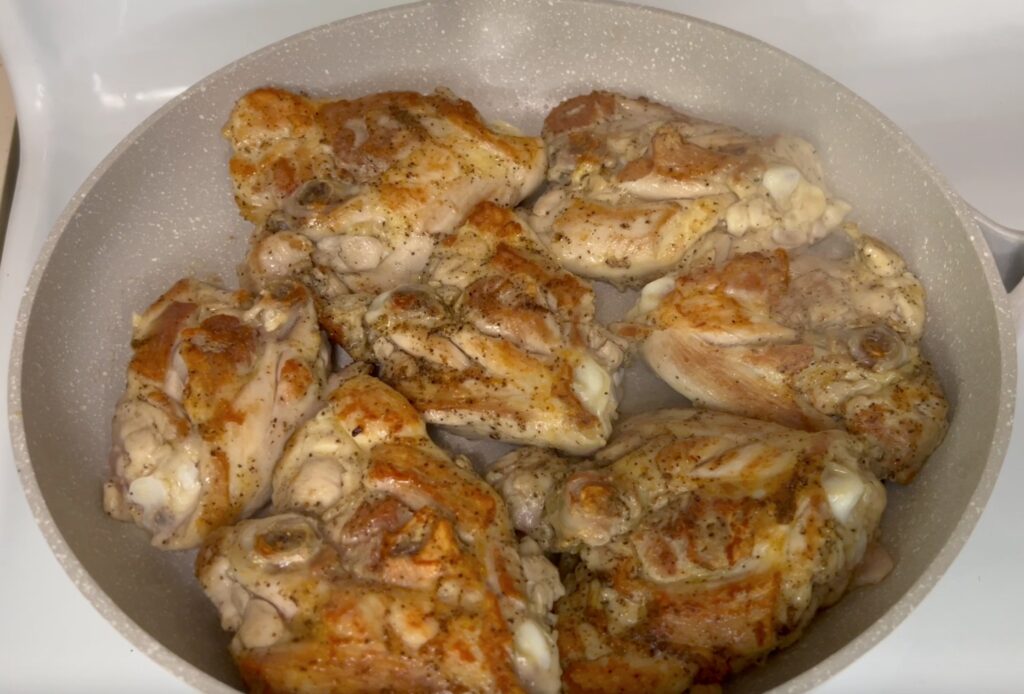
Step 6: Prepare the base of the sauce: In a deep pot, heat two tablespoons of oil. Add the ginger-garlic paste and fry for about 20 seconds. Do not let it brown too much or the garlic may turn bitter. Add ground spices – biriani masala, chicken masala, black pepper, and salt. Fry for about half a minute to bloom the aroma of the spices. Then, add pureed tomatoes, the fried onions, and yogurt. Stir to combine.
Step 7: Add the seared chicken and potatoes. Stir gently, then cover the pot. Reduce the heat to medium-low and cook for 20-25 minutes or until the both the chicken and the potatoes are well done. Do not overcook as the potatoes could crumble. Stir occasionally so the stew does not stick to the bottom of the pot. Set aside when ready.

To Prepare Rice
#1. Measure 2.5 cups of basmati rice and rinse it until it is clean.
#2. Bring 5 cups of water to a boil. Add a tablespoon of oil and salt to taste.
#3. Add rice and stir. Cover the pot and reduce the heat to low. Cook until the water dries up and the rice is well done.
#4. Color the rice (optional). In a small bowl, mix about 4 drops of orange food coloring with 2 tablespoons of cold water. Then, make four small holes in the rice using a fork, and to each hole, add half a tablespoon of the food coloring solution. Cover and cook the rice on low for an additional 3 minutes. Turn the heat off and leave the pot covered. Let the rice stand for a minimum of 5 minutes before fluffing to allow moisture to be absorbed.
#5. Fluff the rice gently to loosen it up and evenly distribute color.

To Serve Chicken Biryani
Serve the colorful rice on a platter and top it with the chicken sauce. Feel free to include a side of sauteed spinach, Swiss chard, or any other leafy vegetable of your choice. Enjoy with a glass of fresh juice.
Storing Leftover Chicken Biryani
- Store the rice and the meat sauce separately. Otherwise, rice will soak up the liquid from the sauce, change in texture, and still be quite dry at the time of reheating.
- Place the leftovers in separate airtight containers and store them in the fridge. Try and use the food within five days to ensure freshness.
- To freeze, divide up the meat sauce into single or double servings and freeze in small Tupperware containers. You can do the same for rice and place it in Ziplocs if necessary. Freezing in small batches will make your work easy as you can pull and reheat only the amount you need for a meal later. Your Chicken biryani will be safe in the freezer for up to two months.

Reheating Leftover Chicken Biryani
You can reheat leftover Biryani in the microwave or on the stovetop. Allow both the rice and the meat sauce to defrost fully before reheating for quick and even heating.
In the microwave: You can choose to reheat the refrigerated or defrosted rice and meat sauce together or separately. Both options work just fine. Place the food in a large bowl or wide plate and heat until warm enough. Consider covering it because meat can pop in the microwave and make a mess.
On the stovetop: Heat the rice and meat sauce separately for best results.
Place rice in a cooking pot. Add 2 tbsp of water per single serving, cover, and heat on low until fully hot. Stir it gently halfway through.
Place the meat sauce in a pot, cover, and heat on low until hot enough. If too thick, add a little water. Stir occasionally so it does not stick to the bottom.
Print The Recipe
Chicken Biryani Recipe – Biriani ya Kuku – Kenyan Biriani
Course: MeatsCuisine: Kenyan, East African, SwahiliDifficulty: Moderate10
servings15
minutes55
minutes700
kcal1
hour10
minutesWhile making this recipe, you can do some steps concurrently, such as cooking the chicken sauce and rice.
Ingredients
Basmati rice -2 ½ cups
Chicken thighs – 7 pieces
Potatoes – 10 small ones
Plain yogurt – 1cup
Biriani masala (or garam masala) – 1 tbsp
Ginger-garlic paste – 2tbsp
Red onions – 4 cups chopped
Tomatoes – 4 medium
Tomato paste – 2 tbsp
Chicken masala and ground black pepper (1 ½ tsp@)
Cooking oil – 2 cups
Salt to taste
Food coloring
Steps for the chicken sauce
- Prepare all the ingredients: chop the onions, crush ginger and garlic, puree the tomatoes, peel the potatoes, and measure out yogurt, tomato paste, and ground ingredients.
- Heat 2 cups of oil in a deep pan. Fry the onions until golden brown. Remove the onions from oil when done and set aside.
- Add about 3 drops of orange food coloring into a tablespoon of water and use the solution to add color to the potatoes. This step is optional. You can choose not to color the potatoes.
- Use the same oil that fried the onions to fry the potatoes for about 5 minutes or until the exterior gets firm. Drain the potatoes and set them aside.
- Place the chicken pieces into a large bowl and sprinkle half a teaspoon each of chicken masala and black pepper. Rub the seasoning in and distribute it evenly.
- In a wide frying pan, heat two tablespoons of oil on high. Add the chicken pieces and sear until browned at the bottom. Flip the pieces and sear the other sides. Set aside.
- In a deep enough pot, heat two tablespoons of oil. Add the ginger-garlic paste and fry for about 20 seconds. Do not let the paste brown too much or the garlic may turn bitter.
- Add ground spices – biriani masala, chicken masala, black pepper, and salt. Fry for 30 seconds to bloom the aroma of the spices.
- Add pureed tomatoes, fried onions, and yogurt. Stir to combine.
- Add the seared chicken and potatoes. Stir gently, then cover the pot. Reduce the heat to medium-low and cook for 20-25 minutes or until both the chicken and the potatoes are well done. Do not overcook as the potatoes could break down. Stir occasionally so the stew does not stick to the bottom of the pot. Set aside when done.
- Steps for rice
- Measure 2.5 cups of basmati rice and rinse it until clean.
- Bring 5 cups of water to a boil. Add a tablespoon of oil and salt to taste.
- Add rice and stir. Cover the pot and reduce the heat to low.
- Cook until the water dries up and the rice is well done.
- Mix about 4 drops of food coloring with 2 tablespoons of cold water. Make four small holes in the rice using a fork and to each, add half a tablespoon of the food coloring solution. Cover and cook the rice on low for an additional 3 minutes. Turn the heat off and leave the rice covered. Let the rice stand for a minimum of 5 minutes before fluffing to allow for moisture absorption.
- Fluff the rice to loosen it up and evenly distribute color.
- Serve the rice on a platter and top with the chicken sauce. Feel free to include a side of sauteed spinach, Swiss chard, or any other leafy vegetable of your choice. Enjoy with a glass of fresh juice.
Recipe Video

